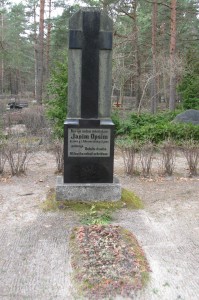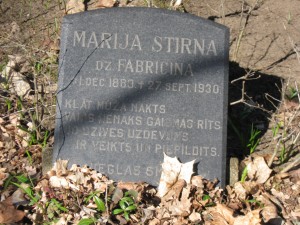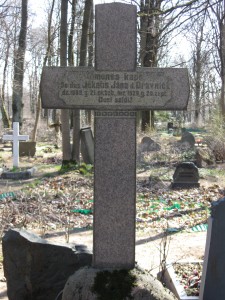Sixth installment from the diary of my great-grandfather’s sister Alise, written during the First World War, just a few miles from the front lines of the Eastern Front. For the background, see here. If you’ve been wondering why there has been a long break from these – your answer will be found here.
August 22, 1915
We are refugees. On August 16, at 7pm, we left our home running and stumbling. Until the last moment we thought we could stay, but our hopes were dashed. We should have already prepared, because there were many signs, that we could not stay. For example, the night before at 1am, we were awoken by loud banging on the door, we awoke in fright, the soldiers were requesting axes, saws and kerosene with which to burn the ferry. The last group of refugees to cross stayed with us with all of their animals. All throughout the night there was terrible noise, running about, screaming, both people and animals. At 4am the ferry was ready, and the fire was set to it and it burned. The sight was incredible, a huge smoke cloud – and the flames on the water – our Daugava – I imagined a sinking burning ship. We started to pack important papers and belongings, and also divided the money and hid it safely. Then we returned to bed. The morning promised a nice day -everyone was still in good spirits, we took in other refugees for lunch, including the millers from the other side of the Daugava, who had paddled across in a small boat and stayed with us. After lunch, they worried about how our soldiers burned down their mill, along with a factory, the stables, the coop and all of their millers’ tools. The women – all three – worried until they fainted, the sight was terrible – one big sea of fire, which grew as the wind spread the flames along thousands of cords of wood, which had been stacked in rows along the banks of the Daugava. The Hardelis family said their goodbyes in tears, for they had been left with no home.
We packed feverishly, and our home was suddenly full of soldiers, taking things here and there, and such anger fills your soul. I asked my daughter to boil tea and eggs, the cakes were out of the oven and we were ready to eat. I put water to boil to warm the children’s baths – and then Vera runs in, who was luckily visiting with us, and told us that shrapnel had just started falling on our side of the Daugava. I grabbed the children, half-dressed and not fed, not even dressed myself, and we ran away to the old castle, where our group was able to hide. The cannonfire was so strong, that even the windows trembled. Also there the soldiers came in and out, the wind blowing in, and my children were cold. TrÅ«tiņa was able to eat, DagmÄriņa – asked for her pacifier (?) – where to get one? I went to the kitchen to the soldiers and asked them for tea and a grain of sugar. Again a commotion – in comes our Papa, red and sweating, agitated to the last straw, and told us that the servants unhooked the horses from the wagons that we needed to take the essentials with us. And so it is – everything needs to stay to be destroyed – we won’t have anything anymore, we who were used to all of life’s comforts.. the soldiers had been going through the packed boxes, tearing apart sheets and Dagiņa’s dresses to wrap their feet. They also loaded up the eggs, tea and cakes onto the table and eaten them in our place – what a terrible fate we have! Through no fault of one’s own people have to suffer so much, lose so much, that you have saved and kept for years. During this time, Father was able to get two horses for our carriage, we got in under the soldiers’ escort and drove off into the dark, towards an uncertain destiny.
I thought, it was a Saturday night, I wanted to bathe the children and put them in warm clean beds, and now, in the dark night, with empty stomachs, without a home, we need to wander… DagmÄriņa cried a lot, and my heart along with her. We arrived at the Krape estate. We waited outside, while Papa asked after a place for the night. We were welcomed warmly, the lady of the house and the girls were especially kind. But still, my mind was heavy, especially for the sake of the children. TrÅ«dÄ«te doesn’t have her books, no doll, and there is no warm place to dry Dagiņa’s pants. We stayed there two restless days. Papa went out to deliver the requisitioned animals and received some money. We stayed in the home shaking in fear because of the strong cannonfire, all of our side of Jumprava was filled with smoke. The impressions were many – the reserve soldiers staying at KrÄpe held a church service under the blue sky. The soldiers sang, the cannons roared, us without our own home, without any belongings – hearts heavy – thinking, what kind of fate awaits us?
Early in the morning we headed off again, far away from everything that we had, that we had saved for a long time, away from everything that held dear memories. We were told that our matresses and duvets, our bottles of blueberries, our jam jars, were thrown about on the shores of the Daugava, to be destroyed or stolen. After some difficulties on the road, heavy winds and rain, we ended up at the NÄ«taure tavern, where we spent the night with the children in a small room. In one place, the horses were frightened of the locomotives and they almost pushed the workers into the ditches. God protected us until everything went still again. Then we headed off again.
Late in the evening we arrived at my father’s house. How wonderful it is to have this home, especially now – fate’s children without a home. In this moment we are received with warm loving hands, well fed, with warm beds. My dear small children need peace, warm milk. Thanks to God we have everything in abundance here, in God’s grace, and there is still peace, we do not hear the terrible cannons or burning fires. But for how long? All of Latvia is in chaos. Thousands of refugees have left their daily work and headed into the unknown, leaving everything that the heart has grown fond of, little can be brought along, sometimes one is unable to bring anything.
The newspapers bring horrible stories of the lives of refugees, who have overcrowded all of Russia’s cities. No work, famine, contagious diseases spreading like wildfire. Newspapers are also filled with notices of people looking for their loved ones. Men looking for their wives, parents their children, some mothers have lost their minds after losing their children on the streets. Many without homes, sleeping in tents in the forests, half-starved. Food is very expensive, rye flour already costs 250 kopecks per pood [approximately 36 pounds], butter is 75 kopecks, cottage cheese 25, and sweetened (?) for 18 kopecks, etc. Sugar, white flour, kerosene is no longer available. We will need to spend the winter with scraps (?) and black bread. We can do it, but my poor little Dagiņa has to immediately get used to rough bread, can’t get any cakes, or pieces of white bread. TrÅ«dÄ«te had better days, but still, DagmÄriņa is a strong girl, for she drinks milk heartily and eats eggs, which Grandmother pushes upon us, not considering the fact that if she were to sell them she could get 9 kopecks per egg.
May God give us health – the future will be uncertain. It will be hard, but one must try, one must be strong, to win.



